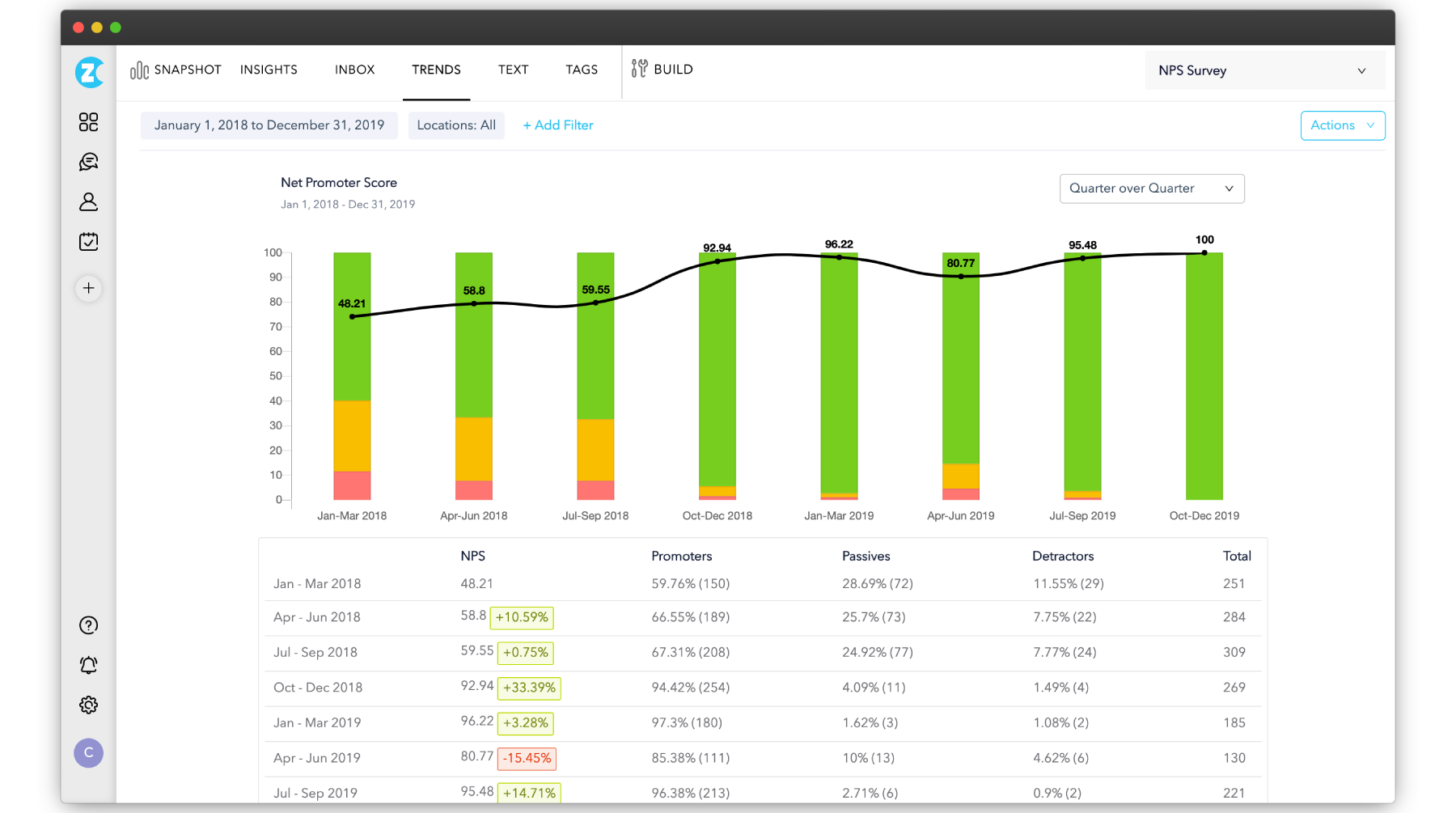Imagine a patient leaving your hospital after a successful treatment. While they were satisfied with the care they received, their experience was marred by a long wait time and a lack of follow-up post-discharge. Despite the positive outcome, the fragmented journey leaves them uncertain about recommending your services. This scenario is all too common in healthcare, where gaps in patient experience can overshadow clinical success.
As the industry shifts toward patient-centric models, addressing these gaps has become paramount. This is where Net Promoter Score (NPS) plays a transformative role. More than just a metric, NPS measures patient satisfaction and loyalty, uncovering actionable insights to improve care quality, enhance trust, and drive organizational growth.
It is no wonder that organizations with high NPS scores grow twice as fast as their competitors. For healthcare providers, the stakes are even higher—better NPS scores translate into stronger patient trust, improved adherence to treatment plans, and valuable word-of-mouth referrals. Leaders like Kaiser Permanente and Johns Hopkins Medicine are already leveraging NPS to optimize patient journeys and maintain their reputation for excellence.
In this blog, we’ll explore how NPS in healthcare is a gamechanger for your organization. From understanding what NPS is to practical tips on using it effectively, we’ll cover everything you need to know to enhance patient satisfaction, improve loyalty, and drive meaningful change in your organization. Let’s dive in!
TL;DR
-
Net Promoter Score (NPS) is an effective metric to measure and improve patient loyalty. It categorizes patients into promoters, passives, and detractors.
-
NPS can be applied in various healthcare scenarios, including multi-location hospitals, telehealth services, and post-discharge care making it a versatile tool for improving patient experiences.
-
Implementing NPS surveys involves strategic dissemination across various touchpoints in different healthcare settings, analyzing the NPS score and closing the feedback loop.
- To maximize the impact of NPS in healthcare, you can integrate NPS with operational KPIs and establish real-time feedback loops.
-
Zonka Feedback is an effective survey software for leveraging NPS in healthcare, offering advanced features for survey creation, data analysis, and actionable insights. You can schedule a demo to explore its features.
Measure Patient Feedback and Satisfaction👩⚕️
Create your healthcare surveys and questionnaires and gauge feedback from patients in real time.

Understanding NPS in Healthcare
As healthcare providers, understanding and improving patient satisfaction is crucial to your success. One effective way to measure this satisfaction is through the Net Promoter Score (NPS). NPS provides you with a straightforward and reliable metric to gauge patient loyalty and satisfaction, helping you to better understand your patients' experiences and make informed decisions to enhance care quality.
What is NPS in Healthcare?
NPS is a metric that quantifies how likely your patients are to recommend your healthcare services to others. It is based on a single, simple question: "On a scale of 0 to 10, how likely are you to recommend our healthcare services to a friend or family member?"

Your patients' responses categorize them into three groups:
-
Promoters (score 9-10): These are your loyal patients who are highly likely to recommend you and contribute positively to your reputation and growth.
-
Passives (score 7-8): These patients are satisfied but not enthusiastic enough to actively promote you. They are also at risk of switching to competitors.
-
Detractors (score 0-6): These patients are unhappy and can negatively impact your reputation through negative word-of-mouth.
-1.png?width=749&height=245&name=Net%20Promoter%20Score%20(NPS)-1.png)
How to Calculate NPS?
Calculating NPS is a straightforward process. Here are the steps:
-
Collect Responses: Administer the NPS survey question to your patients and gather their responses.
-
Categorize Responses: Group the responses into Promoters, Passives, and Detractors based on the scores provided.
-
Calculate the Percentage: Determine the percentage of respondents in each category.
-
Promoter Percentage: (Number of Promoters / Total Respondents) x 100
-
Detractor Percentage: (Number of Detractors / Total Respondents) x 100
-
-
Subtract Detractors from Promoters: Subtract the percentage of Detractors from the percentage of Promoters to obtain the NPS.
Healthcare NPS Formula: Net Promoter Score = % Promoters - % Detractors
For example, if 60% of your respondents are Promoters, 30% are Passives, and 10% are Detractors, your NPS would be 60 - 10 = 50.
By understanding and calculating NPS, you can effectively gauge patient loyalty. This metric serves as a benchmark to track your performance over time and compare with industry standards, providing critical insights for continuous improvement in patient care and satisfaction.
Should your Healthcare Organization Measure NPS?
Determining whether Net Promoter Score (NPS) is the right metric for your healthcare organization requires a deeper understanding of its purpose and alignment with your goals. While NPS has become a widely adopted tool for gauging patient satisfaction and loyalty, its effectiveness depends on how well it fits into your broader patient experience strategy.
Here are two essential considerations to help you decide:
1. Will NPS Provide the Insights You Need?
Before implementing NPS, consider what you aim to learn from patient feedback. Are you looking to measure transactional experiences, such as post-discharge care, or gain a broader understanding of your organization’s reputation within the community?
- Transactional Feedback: If your focus is on specific touchpoints like wait times or post-discharge care, NPS can highlight gaps but works best alongside other KPIs like appointment adherence rates or staff responsiveness for a complete view.
- Relationship Feedback: When the goal is to understand long-term patient loyalty and how it evolves over time, NPS excels as a relationship metric. It reveals whether your patients feel connected to your organization and are likely to recommend your services based on their overall experience.
2. Do You Have an Established Relationship with Your Patients?
The effectiveness of NPS depends on the nature of your interaction with patients. For NPS to provide meaningful insights, your organization should have a relationship that goes beyond a single transaction.
- For Long-Term Care Models: If your organization engages patients through ongoing treatments, follow-ups, or chronic care management, NPS can serve as a powerful metric. It measures the cumulative experience patients have with your services, offering insights into trust, satisfaction, and long-term loyalty.
- For Short-Term Interactions: If your patient relationships are primarily transactional—like one-off emergency room visits or quick pharmacy purchases—NPS may not fully capture the nuances of their experience. In these cases, transactional surveys targeting specific touchpoints (e.g., wait times or service quality) might yield more actionable data.
That being said, if your organization prioritizes building lasting relationships with patients, NPS is a powerful tool to measure and enhance that connection, helping you identify areas of improvement and foster loyalty that translates into positive referrals and advocacy.
Why is Measuring Net Promoter Score in Healthcare Important?
As a healthcare provider, it's essential to continuously monitor and improve patient satisfaction. Healthcare Net Promoter Score (NPS) is a powerful tool that can help you achieve this goal. NPS not only measures patient satisfaction and loyalty but also provides valuable insights into areas where your services can improve. By focusing on NPS, you can promote a culture of continuous improvement, ensuring that your patients receive the best possible care.
How NPS can Grow your Healthcare Business?
Utilizing NPS in your healthcare setting offers numerous advantages. Here's how it helps your business grow:
- Retaining Patients and Reducing Churn: Retaining loyal patients is far more cost-effective than acquiring new ones, and NPS helps you make this happen. By identifying at-risk patients (Detractors) and addressing their concerns, you can reduce churn and build lasting relationships. Research shows that retaining an existing patient can be 5–7 times more cost-effective than finding a new one, making patient loyalty a critical driver of profitability.
- Attracting New Patients Through Advocacy: Patients who are Promoters—those scoring 9 or 10 on your NPS survey—don’t just stick around; they become your ambassadors. Promoters are 4.2 times more likely to recommend your services to others, creating a ripple effect of referrals. This kind of organic word-of-mouth is invaluable in the competitive healthcare market and can significantly boost your patient acquisition without additional marketing spend. Many healthcare providers also look to insights from top healthcare PR firms to refine their patient engagement strategies and strengthen their brand presence in the market.
- Connecting NPS to Better Outcomes: A high NPS doesn’t just mean happy patients—it translates into better clinical and operational results. Patients who trust your organization are more likely to adhere to treatment plans, attend follow-ups, and avoid unnecessary readmissions. For example, studies show that Promoters have a readmission rate of 7.2%, compared to 11.9% for Detractors. These insights allow you to prioritize improvements that enhance both patient care and operational efficiency.
- Driving Revenue Through Experience: There is a strong correlation between patient satisfaction and financial growth. Hospitals with higher NPS scores often report better profitability because happy patients tend to stay loyal, choose additional services, and refer others. According to a report by the Deloitte Center for Health Solutions, hospitals with high patient-reported experience scores see significantly higher revenues, proving that investing in patient satisfaction directly benefits the bottom line.
- Building a Stronger Online Reputation: Your reputation isn’t shaped solely by the care you provide within your walls—it’s defined by the stories your patients share online. NPS helps you monitor patient sentiment in real time, giving you the chance to address concerns before they turn into negative reviews. At the same time, it allows you to leverage positive feedback from Promoters, showcasing your commitment to exceptional care and building trust with prospective patients.
Net Promoter Score Benchmarks
Net Promoter Score healthcare benchmarks are essential for evaluating patient satisfaction and loyalty within the healthcare industry. These benchmarks serve as a reference point, helping providers measure their performance and uncover opportunities for improvement.
The average NPS score healthcare benchmark ranges between +38 and +58, making healthcare one of the highest-performing industries compared to others like SaaS and financial services. However, benchmarks can vary based on factors such as specialty, patient demographics, and geographic location.
Defining benchmarking in healthcare allows organizations to set realistic goals, track progress, and enhance their service quality. Regularly comparing your NPS score against industry benchmarks ensures that you stay competitive while continuously improving patient experiences.
What is a Good Net Promoter Score in Healthcare?
A good NPS score for healthcare exceeds the average industry benchmark. So, anything above +58 are considered excellent, while those above +80 are regarded as world-class. Achieving a strong NPS score signals that your organization has more Promoters than Detractors and is successfully fostering patient loyalty. Organizations like MedAvail, with a score of +90, demonstrate how actionable feedback and patient-focused initiatives lead to outstanding results.
Net Promoter Score Healthcare Benchmarks for Top Healthcare Providers
Several top healthcare providers stand out for their exceptional NPS scores, showcasing how prioritizing patient feedback can elevate satisfaction and loyalty:
| Healthcare Organization | NPS Score | Standout Focus |
| CIMA Hospital | 96 | Advanced medical technology |
| International Hospital Corp | 93 | Operational efficiency and patient-centric care |
| MDI NetworX | 91 | Innovative solutions and patient focus |
| Alliance Healthcare Services, Inc. | 90 | Diagnostic expertise and innovation |
| Ear Health Wellington Ltd | 86 | Tailored audiology and patient education |
1. CIMA Hospital – NPS: 96
CIMA Hospital's industry-leading score of 96 reflects its focus on advanced medical technology, personalized care, and seamless patient experiences.
2. International Hospital Corp – NPS: 93
With an NPS of 93, International Hospital Corp excels in operational efficiency and compassionate care, building trust and loyalty among patients.
3. MDI NetworX – NPS: 91
MDI NetworX's dedication to innovative healthcare solutions and patient-centric service has earned it a remarkable score of 91.
4. Alliance Healthcare Services, Inc. – NPS: 90
Alliance Healthcare Services specializes in diagnostic and therapeutic services, achieving an NPS of 90 by prioritizing innovation and patient satisfaction.
5. Ear Health Wellington Ltd – NPS: 86
Ear Health Wellington’s tailored audiology services and emphasis on patient education result in a strong NPS score of 86.
Practical Applications of NPS in Healthcare
Now that you know the benchmarks, let's explore how you can implement NPS across various aspects of healthcare:
1. NPS for Multi-Location Hospitals and Clinics
For healthcare systems operating multiple facilities, maintaining consistent care across locations can be a concern. NPS helps identify which hospitals or clinics are excelling and which ones need improvement. For example, if you run a healthcare chain, you can use NPS to identify recurring issue at one clinic—long patient wait times. By hiring additional staff and optimizing appointment scheduling, you can reduce wait times and improve patient satisfaction.
Here's how you can implement NPS for multi-location hospitals and clinics:
- Use location-based NPS surveys to capture patient feedback at each branch, tailored to specific touchpoints like appointment scheduling, consultations, and follow-ups.
- Access detailed NPS reports for each location to identify patterns. For instance, one clinic might excel in physician communication while another struggles with long wait times.
- Automated workflows can trigger action items when Detractor feedback is received, such as assigning specific teams to resolve recurring issues.
- Empower location managers with direct access to their facility’s feedback to make faster, targeted improvements.
2. NPS for Staff Performance and Training
Staff interactions play a pivotal role in shaping the patient experience, from bedside manners to clarity in communication. NPS surveys help identify how these interactions impact satisfaction and uncover areas where training is needed. For example, an oncology department might receive Detractor feedback indicating that patients feel rushed during consultations. Using these insights, the department could introduce time management strategies and empathy-focused training, resulting in improved patient satisfaction and higher NPS scores.
To further use NPS to improve patient experience, you can:
- Add follow-up questions to NPS surveys to capture feedback on staff behavior, such as attentiveness, communication clarity, and friendliness. For instance, questions like, “Was your provider thorough in explaining your treatment options?” can offer actionable insights.
- Use NPS results to design personalized training programs focusing on empathy, communication, and procedural clarity.
- Recognize high-performing staff based on NPS Promoter feedback to boost morale and create role models for others.
- Set up peer-to-peer mentoring programs where high-performing staff can share best practices with colleagues, fostering a culture of continuous improvement.
3. NPS for Post-Discharge Care Follow-Up
The patient journey extends beyond the hospital walls, and post-discharge care is a vital phase that significantly impacts patient satisfaction and outcomes. NPS surveys provide a clear lens into this critical touchpoint, offering actionable insights to enhance recovery experiences. For example, if NPS feedback highlights confusion about post-surgery care, healthcare providers can address this by introducing personalized follow-up calls and digital recovery resources tailored to patient needs. These actions not only improve satisfaction but can also reduce readmission rates.
Here’s what you can do in a post-discharge care follow-up:
- Send post-discharge NPS surveys promptly to capture fresh feedback about recovery instructions, medication adherence, and follow-up care. Time the surveys within 48–72 hours after discharge for maximum relevance.
- Create automated workflows for Detractor feedback, such as alerting care teams when patients report issues like unclear discharge instructions or a lack of follow-up for immediate action.
- Implement personalized follow-up protocols, including scheduled check-in calls, SMS reminders for medication adherence, or sending recovery milestones via email.
- Introduce recovery support tools, such as digital guides, videos, or mobile apps that provide step-by-step instructions and track progress.
- Segment NPS results by condition or procedure type to identify patterns. For instance, patients recovering from orthopedic surgeries might consistently report needing better mobility guidance, prompting tailored follow-up materials.
4. NPS for Emergency Department (ED) Experience
Emergency departments (EDs) are often high-pressure environments where delays, poor communication, and overcrowding can lead to dissatisfaction, Improving communication channels such as a healthcare call center can ensure patients feel cared for even after their initial visit. NPS surveys provide actionable insights to improve patient experiences by identifying and addressing key concerns. For instance, if NPS data highlights frustrations about long wait times, introducing digital wait-time updates and optimizing triage processes can significantly enhance efficiency and patient satisfaction.
Here’s what you can do to improve ED experience with NPS:
- Deploy real-time NPS surveys post-discharge to gather feedback on wait times, triage efficiency, and staff interactions during the ED visit.
- Implement digital tools like wait-time displays to keep patients informed and reduce perceived delays in care.
- Streamline triage processes using NPS insights by assigning additional resources during peak hours to reduce bottlenecks.
- Train staff on patient communication strategies to ensure regular updates and clear explanations of care procedures, reducing anxiety and frustration.
- Segment NPS data by visit type (e.g., walk-in emergencies or ambulance arrivals) to understand specific patient needs and pain points.
- Act on Detractor feedback immediately by contacting dissatisfied patients to resolve concerns and improve retention.
5. NPS for Patient Advocacy Programs
Promoters—those who rate your healthcare services highly on NPS surveys—are powerful allies for spreading positive word-of-mouth and enhancing your reputation. For example, a cancer treatment center could identify Promoters through NPS surveys and engage them in storytelling campaigns to share their recovery journey. These testimonials not only build trust among prospective patients but also position the center as a compassionate and reliable provider.
Here’s what more you can do:
- Establish referral programs that reward Promoters for introducing new patients. Incentives like discounts, wellness packages, or recognition can motivate loyal patients to actively refer others.
- Incorporate Promoters’ feedback into case studies, blog posts, or video testimonials to showcase the quality of care and build emotional connections with potential patients.
- Create Promoter ambassador programs where patients can participate in events, webinars, or community outreach initiatives, helping to amplify your organization’s mission and values.
- Leverage social media engagement by encouraging Promoters to leave reviews or share their stories online. Highlight these posts on your platforms to enhance visibility and credibility.
- Use NPS to identify trends among Promoters, such as specific services or staff members they appreciate most. Highlight these insights in marketing campaigns to attract more patients who value similar qualities.
6. NPS for Telehealth Services
As telehealth continues to grow, understanding how patients perceive virtual care is essential for its success. NPS surveys provide insights into critical areas like technology ease-of-use, appointment accessibility, and communication quality. For example, if NPS surveys reveal consistent feedback from Detractors about trouble accessing the telehealth platform, you might discover that the login process is overly complex. By introducing a single-click authentication system or providing guided tutorials for first-time users, you can address these issues and improve the telehealth experience.
Here’s what more you can do:
- Customize NPS surveys for telehealth-specific touchpoints to capture feedback on aspects like ease of scheduling, user interface, and the quality of virtual interactions.
- Monitor technical performance trends using NPS data to identify recurring issues, such as call drops or video lags, and prioritize improvements in platform stability.
- Introduce post-session summaries that address common patient concerns, such as unclear treatment instructions or next steps, to enhance the follow-up experience.
- Offer real-time support based on Detractor feedback by integrating live chat or helpline options for patients facing technical issues during their telehealth appointments.
- Segment NPS feedback by demographic or device usage to better understand how specific patient groups, like seniors or mobile users, experience telehealth differently and tailor improvements accordingly.
- Use Promoter feedback to refine marketing efforts by highlighting aspects of telehealth services that patients love, such as convenience or accessibility, to attract more users.
Implementing NPS Surveys in Healthcare
Implementing NPS surveys in your healthcare practice is essential for gaining valuable insights into patient satisfaction and loyalty. By systematically collecting and analyzing patient feedback, you can identify areas for improvement and enhance the overall patient experience. This section will guide you through the process of implementing NPS surveys effectively, covering crucial aspects such as survey design, distribution, data analysis, and taking action on the feedback received.
1. Designing Effective NPS Surveys
Creating effective NPS surveys is the foundation of gathering meaningful patient feedback. To gather deeper insights into patient experiences and preferences, you need to:
-
Choose an Appropriate Template: Good patient experience tools provide ready-to-use templates specifically designed for healthcare settings. Select a relevant template and customize it to fit your survey needs, ensuring it aligns with your objectives and captures the information you need.
-
Customize Questions: Start with the core NPS question: "On a scale of 0 to 10, how likely are you to recommend our healthcare services to a friend or family member?" Add follow-up questions to understand patient expectations and the reasons behind their rating. Include additional questions addressing key aspects of patient experience, such as the quality of care, communication, wait times, and facility cleanliness.
-
Implement Skip Logic and Question Branching: Use skip logic and question branching to tailor the survey based on previous responses. This ensures that patients only see questions relevant to their experience. For example, if a patient gives a high NPS score, skip questions about issues and instead ask for positive feedback or suggestions for maintaining high standards.
-
Assure Confidentiality and Anonymity: Assure patients that their responses are confidential and will be used solely for improving services to encourage honest and open feedback. Consider offering anonymous surveys to further assure patients that their identity will not be revealed.
2. Strategic Sharing NPS Surveys in Different Healthcare
The next step in implementing NPS surveys in healthcare settings requires strategic dissemination to ensure comprehensive feedback across various touchpoints. The approach varies depending on the type of healthcare facility and the patient journey within each setting. Here’s how you can do it:
a. Hospitals and Clinics
Hospitals and clinics cater to diverse patient needs, from routine check-ups to specialized treatments. To gather meaningful feedback, it’s essential to target specific patient interactions in outpatient and inpatient settings.
Outpatient Departments
Outpatients have shorter, more focused interactions with healthcare providers, making it critical to capture feedback at key points in their journey.
Touchpoints
- Post-Consultation: Send surveys after consultations with general practitioners or specialists to assess the quality of care.
- Post-Procedure: Gather feedback following minor outpatient treatments to evaluate the overall experience.
- Post-Appointment: Immediately post-visit surveys to gauge satisfaction with scheduling, wait times, and staff interactions.
Channels
Email Surveys: Send automated email surveys shortly after the appointment or procedure, ensuring the experience is still fresh in the patient's mind.
SMS Surveys: Utilize SMS for quick feedback, especially for patients who might prefer a short and simple survey on their mobile devices.
Kiosks/Tablets: Place kiosks or tablets in the waiting areas or at checkout points for immediate feedback collection before patients leave the facility.
Inpatient Departments
Inpatients have extended interactions with the healthcare facility, making it crucial to capture their feedback at multiple stages.
Touchpoints
- During Hospital Stay: Mid-stay surveys to gauge ongoing satisfaction.
- At Discharge: Comprehensive feedback at the time of discharge.
- Post-Discharge: Follow-up surveys to understand the patient's experience post-treatment and any aftercare feedback.
- Post-Admission: Shortly after admission to gather initial impressions of the facility and staff.
Channels
In-room Tablets: Provide tablets in patient rooms for ongoing feedback during their stay.
Email or SMS: Send follow-up surveys via email or SMS a few days after discharge to capture post-discharge experiences.
Phone Calls: Conduct personalized follow-up calls for detailed feedback, especially for critical cases.
b. Aged Care Facilities
Aged care facilities require a sensitive and tailored approach to gather feedback, considering the unique needs of elderly residents.
Touchpoints
- Post-Admittance: Shortly after a new resident is admitted.
- Regular Intervals: Monthly or quarterly check-ins to monitor ongoing satisfaction.
- Post-Event or Activity: After significant events or activities conducted within the facility.
Channels
Face-to-Face Interviews: Personal interviews conducted by staff or volunteers for detailed feedback, considering some residents might not be tech-savvy.
Paper Surveys: Easy-to-fill paper surveys that can be collected by staff.
Family Surveys: Email or postal surveys sent to family members to gather their perspective on the care provided to their loved ones.
c. Pharmacies
Pharmacies can utilize NPS surveys to understand patient satisfaction with their services and identify areas for improvement.
Touchpoints
- Post-Purchase: Immediately after purchasing medications or health products.
- After Consultations: Following consultations with pharmacists for medication advice or health consultations.
Channels
Receipt-Based Surveys: Include a survey link or QR code on receipts that customers can scan to provide feedback.
SMS or Email: Send follow-up SMS or email surveys after purchase or consultation to capture immediate reactions.
In-Store Kiosks: Place kiosks at the pharmacy exits for quick, on-the-spot feedback.
d. Diagnostics & Imaging Labs
Diagnostics and imaging labs are essential to the patient care continuum, and their feedback mechanisms must address both service quality and operational efficiency.
Touchpoints:
- Post-Test: Surveys immediately after diagnostic tests or imaging procedures to capture the patient’s experience with the process.
- Results Delivery: Collect feedback on how clearly and efficiently results were communicated.
Channels:
SMS or Email Surveys: Share surveys after the patient receives their results to evaluate the clarity and timeliness of the delivery.
On-Site Tablets or Kiosks: Place these in waiting areas or near test completion points for quick and easy feedback.
Mobile App Notifications: If your lab has an app, prompt patients to share their experience directly within the platform.
3. Analyzing and Interpreting NPS Data
Collecting NPS data is just the beginning. To truly benefit from this feedback, healthcare providers need to effectively analyze and interpret the data. Here's how you can efficiently process and use NPS data:
a. How to Analyze NPS scores?
You can follow these simple steps to analyze the NPS scores:
- Aggregate and Calculate: Combine responses in a centralized system, calculate NPS by subtracting the percentage of Detractors from Promoters, and track the overall score for a quick view of patient loyalty.
- Segment Data: Break down NPS scores by departments, services (outpatient vs. inpatient), or patient demographics to identify specific areas needing attention.
- Track Trends: Monitor monthly, quarterly, or yearly trends to detect fluctuations in patient satisfaction and identify the impact of any operational changes.
- Compare Subgroups: Analyze subgroup performance to see which teams or services perform well and where improvements are needed—for example, comparing NPS scores between outpatient and inpatient services.

b. Leveraging AI Analytical Features
Here's how you can leverage AI analytics to enhance your patient care:
- Sentiment Analysis: Utilize AI-powered sentiment analysis tools to automatically analyze the text comments from patients. Sentiment analysis can categorize feedback as positive, negative, or neutral, providing a deeper understanding of patient emotions and attitudes. For example, if negative sentiment clusters around “long wait times,” prioritize addressing operational bottlenecks.
- Text Analysis: Use text analysis to identify common themes and keywords in patient feedback. This involves processing and categorizing large volumes of text to uncover recurring issues or areas of excellence. For example, frequent mentions of “billing issues” in negative comments indicate a need to streamline payment processes.
- Root Cause Analysis: Conduct root cause analysis to dig deeper into low NPS scores or recurring issues to uncover specific factors driving dissatisfaction. For instance, low scores in post-surgery care might reveal gaps in patient education or follow-up protocols.
- Dashboard and Reporting Tools: Implement AI-driven dashboards and reporting tools that provide real-time insights and visualizations of your NPS data. These tools can generate detailed reports, highlight key metrics, and track progress over time.
4. Taking Action on Feedback Collected through NPS Surveys
Collecting and analyzing NPS data is crucial, but the true value comes from taking action based on the insights gained. This involves addressing identified issues, implementing improvements, and communicating changes to patients. Closing the feedback loop is an essential part of this process, ensuring that patients feel heard and valued.
Steps to Take Action on NPS Feedback
- Identify Key Areas for Improvement: Prioritize the areas that have the most significant impact on patient satisfaction. Use the insights from your NPS analysis to focus on specific issues that need immediate attention. For example, if feedback indicates long wait times are a major concern, prioritize initiatives to streamline scheduling and reduce wait times.
- Develop a Response Plan: Create a detailed action plan to address the identified issues. This plan should include specific steps, responsible parties, timelines, and required resources. For instance, to tackle long wait times, your plan might involve hiring additional staff, implementing a more efficient appointment scheduling system, and regularly monitoring wait times.
- Implement Changes: Execute the response plan by making the necessary changes to your processes, systems, or services. Ensure that all relevant staff members are informed and trained on the new procedures. For example, roll out the new appointment scheduling system, provide training for staff, and start monitoring the impact on wait times.
- Monitor and Evaluate Progress: Continuously track the effectiveness of the implemented changes using NPS surveys and other feedback mechanisms. Adjust the approach as needed based on ongoing feedback. For instance, conduct follow-up NPS surveys to assess whether patients are noticing improvements in wait times and overall satisfaction.
5. Closing the Feedback Loop
The last and the final step is to close the feedback loop with your patients so that they feel valued and heard. For this, you must:
- Acknowledge Feedback: Let patients know that their feedback has been received and appreciated. This can be done through automated responses for online surveys or personal follow-up calls for more detailed feedback. For example, send an email thanking patients for their feedback and informing them that their input is being used to improve services.
- Communicate Actions Taken: Keep patients informed about the changes you have made based on their feedback. For instance, send a follow-up email or newsletter detailing the new appointment scheduling system and how it aims to reduce wait times.
- Showcase Success Stories: Highlight success stories and positive outcomes resulting from patient feedback. Sharing these stories can motivate both staff and patients, demonstrating the real impact of their contributions. For example, feature a case study on your website or social media showcasing how patient feedback led to a reduction in wait times and improved patient satisfaction.
Best Practices for Using NPS More Effectively in Healthcare
To make the most of NPS in healthcare, organizations must go beyond simply collecting feedback. Here are actionable best practices to leverage NPS data for improving patient satisfaction, loyalty, and overall experience:
- Engage Promoters for Advocacy: Actively reach out to Promoters and encourage them to share their positive experiences through online reviews, testimonials, or social media shoutouts. For example, invite loyal patients to participate in advocacy campaigns highlighting their care journey, which can enhance trust and attract new patients.
- Turn Detractors into Advocates: Address negative feedback swiftly by reaching out to Detractors, resolving their concerns, and following up to ensure satisfaction. Quick intervention can convert dissatisfied patients into loyal advocates. Research shows that increasing retention by just 5% can boost profits by up to 95%, underscoring the importance of turning detractors around.
- Focus on Passives to Prevent Churn: Reach out to Passive respondents to understand their reservations and offer personalized solutions to exceed their expectations. For instance, surprise them with superior customer service or loyalty rewards to nurture their trust and move them toward becoming Promoters.
- Integrate Feedback into Training: Use NPS insights to identify common patient concerns related to staff interactions or communication gaps. Develop targeted training programs for staff to address these issues, ensuring consistent and empathetic care delivery.
- Monitor Trends and Benchmark Performance: Regularly review NPS trends over time and compare scores across departments or facilities. Benchmark against industry standards to identify where your organization stands and prioritize areas for improvement.
Strategies for Leveraging NPS in Healthcare
Now that you know how to implement NPS in healthcare, you should also make it more impactful by using some impactful strategies. Here are some:
1. Predicting Healthcare Trends with NPS Feedback
NPS feedback is a goldmine of information that can reveal emerging patient expectations and healthcare trends. By analyzing patterns in Promoter and Detractor feedback, you can anticipate shifts in patient preferences and adjust services to meet future needs.
For instance, say you run an outpatient clinic and through NPS surveys, you noticed that Promoters frequently praised telehealth for its convenience, while Detractors expressed dissatisfaction with long wait times for in-person visits. This insight can prompt to expand telehealth offerings while optimizing in-person scheduling to reduce wait times. You can further:
- Use AI-driven sentiment analysis on NPS comments to uncover trends like rising demand for digital health services or increased expectations for shorter wait times.
- Identify patterns across specific demographics (e.g., younger patients preferring mobile-first solutions) to tailor services accordingly.
- Share trend insights across teams to drive innovation, such as introducing mental health services in response to recurring patient feedback.
2. Integrating NPS with Operational KPIs
Connecting NPS scores with operational metrics helps healthcare organizations measure how satisfaction impacts efficiency, outcomes, and growth. This integration provides a holistic view of performance and identifies areas where operational improvements can boost patient satisfaction.
For example, when you integrate NPS data with discharge efficiency metrics, you might find that lower NPS scores correlate with delayed discharge processes. By introducing automated discharge systems and improving staff training, you can reduce delays and increase your NPS.
Here's what more you can do:
- Combine NPS data with metrics like readmission rates, appointment adherence, or staff responsiveness to identify areas needing operational changes.
- Track the ROI of operational adjustments by monitoring how changes—such as adding more appointment slots or upgrading technology—impact NPS scores.
- Include NPS trends in departmental KPIs to align team goals with patient satisfaction improvements.
3. Establishing Real-Time Feedback Loops
Real-time NPS feedback loops enable healthcare providers to address patient concerns immediately, fostering trust and loyalty. Quick response mechanisms ensure that feedback is acted upon while the patient experience is still fresh.
For instance, a telehealth provider used real-time NPS feedback to identify recurring technical issues during virtual consultations. Immediate action—such as offering live tech support and implementing a user-friendly interface—helped resolve problems quickly, improving patient satisfaction and boosting NPS scores. For this, you can:
- Use real-time alerts for low NPS scores, allowing staff to reach out to dissatisfied patients and address concerns before they escalate.
- Create dashboards for live feedback monitoring that allow teams to adjust services, such as triage workflows or wait-time updates, in real-time.
- Integrate NPS with predictive analytics to identify patients at risk of dissatisfaction and take preventive measures.
How Zonka Feedback Helps in Improving Net Promoter Score in Healthcare?
Zonka Feedback offers a powerful suite of features and capabilities that helps healthcare organizations to capture actionable insights, improve patient satisfaction, and streamline operations across all touchpoints. Here's how it stands out in healthcare NPS implementation:
- Omnichannel Feedback Collection: You can collect feedback through multiple channels, including SMS, email, WhatsApp, kiosks to ensure no patient is left unheard. This eliminates the issue of fragmented feedback by centralizing input from various touchpoints.
For instance, a patient visiting a clinic can provide feedback via a kiosk, while a telehealth patient can share their experience through an SMS survey. This inclusivity enhances response rates and captures a holistic view of the patient journey. - Entity-Driven Feedback Management: You can track feedback at granular levels such as location, staff, and specific processes. By segmenting feedback by entities, you can pinpoint underperforming clinics, staff members, or workflows.
For example, if one location consistently receives lower NPS scores, management can identify issues like staff shortages or operational inefficiencies and take corrective action. - AI-Powered Sentiment and Themes Analysis: Leverage AI to analyze patient comments, categorize feedback by sentiment (positive, neutral, or negative), and identify recurring themes tied to locations or staff. This helps uncover hidden pain points such as poor communication or long wait times, enabling providers to prioritize improvements.
- Integration with HMIS/EHR Systems and Patient Portals: Seamlessly integrate feedback systems with existing healthcare infrastructure, including HMIS, EHRs, and patient portals. This ensures a two-way data sync, allowing patient records and feedback to inform each other.
For example, feedback linked to patient treatment histories can help track loyalty and identify patients at risk of churn. - Automated Workflows and Task Management: Automate workflows to assign tasks, trigger surveys, and send notifications based on feedback. This ensures immediate action on critical feedback, such as alerting staff when a patient leaves negative comments. Automated workflows also improve grievance management by creating tickets for unresolved issues, helping reduce patient churn.
- Unified Response Inbox: You can consolidate feedback from all channels into a single, centralized response inbox for easy access and action. This prevents oversight and streamlines grievance management.
For instance, all feedback about a specific location or staff member can be reviewed and addressed in one place, ensuring consistency and accountability.
Those are some of the popular features that companies have used to improve their patient trust and loyalty. One such company is Sankara Eye Hospitals. They have leveraged Zonka Feedback to transform their patient experience across 13 locations. Faced with challenges like fragmented feedback and inefficiencies in traditional methods, they implemented Zonka Feedback’s solutions to streamline operations and enhance patient care. You can read all about their success story here.
- The centralized dashboard allowed them to analyze feedback trends, compare performance across locations, and address underperforming areas with targeted actions.
- Location-based insights highlighted discrepancies in satisfaction, enabling immediate improvements, such as optimizing staff allocation and reducing wait times.
- By replacing traditional methods with a seamless feedback system, Sankara ensured efficient data collection, while real-time alerts allowed staff to resolve grievances promptly, fostering trust and loyalty.
The result of implementing Zonka Feedback in their healthcare setting?
They achieved a 30% increase in feedback volume, gathering over 2.8 lakh responses, including 80,000 inpatient and nearly 2 lakh outpatient surveys. NPS analysis guided continuous improvements, boosting patient satisfaction and loyalty. This shift positively impacted their reputation and growth, with patients praising the personalized care and responsiveness.
Conclusion
Implementing NPS surveys in healthcare is a powerful strategy to measure and improve patient satisfaction. By identifying key areas for improvement, developing response plans, and taking action based on patient feedback, healthcare providers can enhance the overall patient experience. Closing the feedback loop ensures that patients feel heard and valued, promoting loyalty and trust. An effective patient feedback software can facilitate this process, making it easier to gather, analyze, and act on patient feedback.
Zonka Feedback is the right tool for healthcare providers looking to leverage NPS to improve patient satisfaction as it helps you effortlessly create, share and analyze NPS surveys tailored to your specific needs. Its advanced features like AI sentiment analysis, workflow automation and reporting and analytics help you gain deeper insights into patient feedback.
Schedule a demo and discover how easy it is to measure NPS, analyze data, and implement changes to elevate patient satisfaction and deliver exceptional patient care!



.png)







